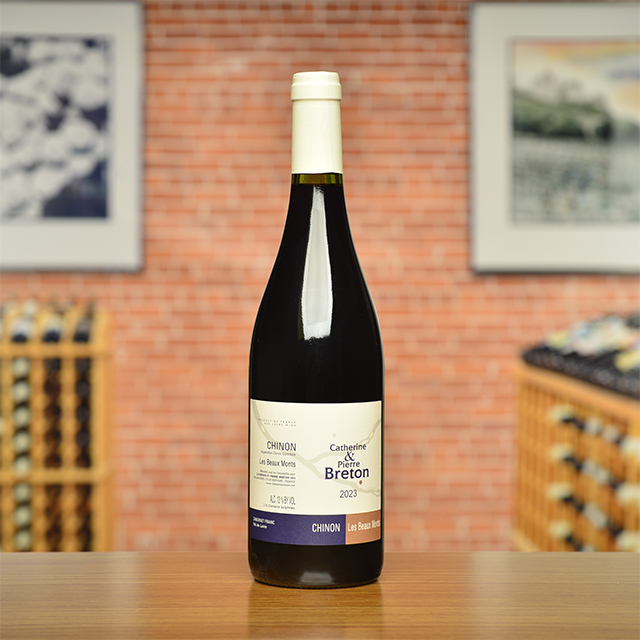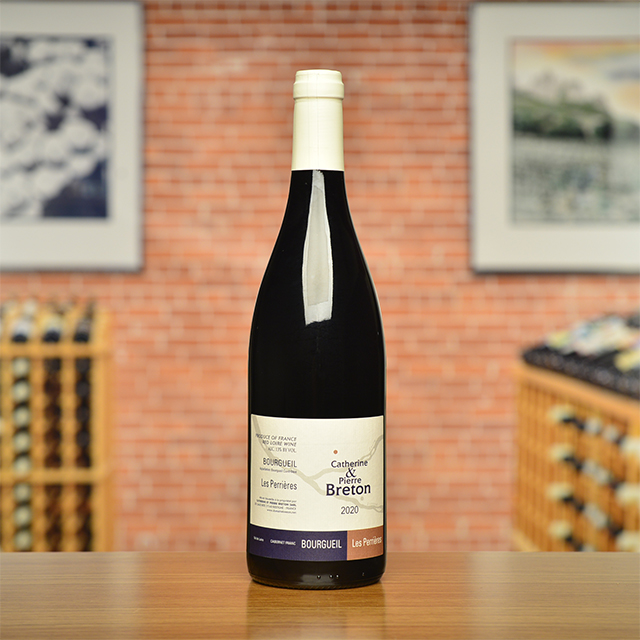Notify me
2021 Bourgueil Clairet “Avis de Vin Fort”
Catherine & Pierre Breton
Catherine and Pierre describe this light, spring red as “cabernet franc like a sea breeze.” There’s lots of fresh fruit with little tannins. The wine’s name is a reference to the maritime warning “Avis de Vent Fort” (meaning strong winds are in the forecast), is a play on words to evoke the idea that if the weather is bad, one should sail back to shore and have a glass of wine instead.
—Dustin Soiseth
| Wine Type: | red |
| Vintage: | 2021 |
| Bottle Size: | 750mL |
| Blend: | Cabernet Franc |
| Appellation: | Bourgueil |
| Country: | France |
| Region: | Loire |
| Producer: | Catherine & Pierre Breton |
| Vineyard: | 40-50 years |
| Soil: | Gravel, clay, limestone |
| Farming: | Biodynamic (certified) |
| Alcohol: | 13.5% |
More from this Producer or Region

2021 Bourgueil “La Dilettante”
France | Loire
A delicate, aromatic red in the “drink now!” vein.

2020 Bourgueil “Nuits d’Ivresse”
France | Loire
Bottled without any sulfur whatsoever, here is a seriously playful Cab Franc from the masters of vinous fun.

Vouvray Brut “La Dilettante”
France | Loire
Dry Champagne-method sparkler that delivers tremendous value.

2022 Bourgueil “Franc de Pied”
France | Loire
Serve it with a slight chill, and you’ll have a satisfyingly fresh red with medium fruit and a light dusting of herbs and tannin.

2019 Bourgueil “Les Perrières”
France | Loire
The family’s grandest wine, a brooding elixir of satiny fruit, cedar, and graphite.

2022 Bourgueil Clairet “Avis de Vin Fort”
France | Loire
Fresh and punchy Cabernet Franc from fun-loving Catherine and Pierre Breton. Light, juicy, and ready to go. Drink young, drink chilled, drink plenty.

2023 Chinon “Beaux Monts”
France | Loire
Sourced from the village of Beaumont, it is utterly delicious, with a perfect balance of fruit and earth.

2023 Vin de France Brut Nature “Elle est pas bulle, la vie?”
France | Loire
Delicious and honest naturally sparkling Chenin, bottled with no dosage and no sulfur.

2019 Vouvray “Bois Guyon”
France | Loire
Unique in its combination of honeyed richness and flinty verve. Hard to resist on its own, but you might also try serving it with salty-sweet yakitori or buffalo chicken wings.

2020 Bourgueil “Les Perrières”
France | Loire
The family’s grandest wine, a brooding elixir of satiny fruit, cedar, and graphite.
About The Producer
Catherine & Pierre Breton
About The Region
Loire

The defining feature of the Loire Valley, not surprisingly, is the Loire River. As the longest river in France, spanning more than 600 miles, this river connects seemingly disparate wine regions. Why else would Sancerre, with its Kimmeridgian limestone terroir be connected to Muscadet, an appellation that is 250 miles away?
Secondary in relevance to the historical, climatic, environmental, and cultural importance of the river are the wines and châteaux of the Jardin de la France. The kings and nobility of France built many hundreds of châteaux in the Loire but wine preceded the arrival of the noblesse and has since out-lived them as well.
Diversity abounds in the Loire. The aforementioned Kimmeridgian limestone of Sancerre is also found in Chablis. Chinon, Bourgueil, and Saumur boast the presence of tuffeau, a type of limestone unique to the Loire that has a yellowish tinge and a chalky texture. Savennières has schist, while Muscadet has volcanic, granite, and serpentinite based soils. In addition to geologic diversity, many, grape varieties are grown there too: Cabernet Franc, Chenin Blanc, Sauvignon Blanc, and Melon de Bourgogne are most prevalent, but (to name a few) Pinot Gris, Grolleau, Pinot Noir, Pineau d’Aunis, and Folle Blanche are also planted. These myriad of viticultural influences leads to the high quality production of every type of wine: red, white, rosé, sparkling, and dessert.
Like the Rhône and Provence, some of Kermit’s first imports came from the Loire, most notably the wines of Charles Joguet and Château d’Epiré—two producers who are featured in Kermit’s book Adventures on the Wine Route and with whom we still work today.
More from Loire or France
2021 Vin de France Rosé Grolleau/Cabernet Franc “Les Arceaux”
Grange Saint-Sauveur France | Loire
2022 Bourgueil “Franc de Pied”
Catherine & Pierre Breton France | Loire
2022 Sancerre Rouge “Le Chant de l’Archet”
Daniel Chotard France | Loire
2021 Saumur Champigny “La Marginale”
Thierry Germain France | Loire
2023 Chinon “Beaux Monts”
Catherine & Pierre Breton France | Loire
2023 Val de Loire Rouge Grolleau
Catherine & Pierre Breton France | Loire
2018 Saumur Blanc “L’Échelier”
Thierry Germain France | Loire
2023 Menetou-Salon Blanc “Le Prieuré”
Prieuré de Saint Céols France | Loire
2023 Muscadet Côtes de Grand Lieu sur lie “La Nöe”
Eric Chevalier France | Loire
2018 Saumur Blanc “Le Clos du Moulin”
Thierry Germain France | Loire
2023 Savennières “Cuvée Spéciale”
Château d’Epiré France | Loire
Loire Valley Wine Route Sampler
12-Bottle Sampler France | Loire
Sampler Includes:
2023 Vin de France Brut “Elle est pas bulle, la vie?” • Catherine & Pierre Breton $25.00
2023 Muscadet “Le Clos de la Butte” • Eric Chevalier $22.00
2023 Quincy • Domaine Trotereau $27.00
2023 Vouvray • Champalou $28.00
2023 Pouilly-Fumé “Vieilles Vignes” • Régis Minet $34.00
2023 Reuilly Pinot Gris Rosé • Domaine de Reuilly $24.00
2023 Bourgueil “Cuvée Alouettes” • Domaine de la Chanteleuserie $18.00
2023 Chinon “Les Granges” • Bernard Baudry $27.00
2023 Val de Loire Rouge Grolleau • Catherine & Pierre Breton $29.00
2023 Sancerre Rouge • Daniel Chotard $40.00
2022 Saumur Champigny “Terres Chaudes” • Domaine des Roches Neuves $42.00
2022 Vin de France Rouge “Le Martray” • Grange Saint Sauveur $49.00
Normally $363.00
SPECIAL SAMPLER PRICE $269.00
(a 25% discount)
2021 Vin de France Rosé Grolleau/Cabernet Franc “Les Arceaux”
Grange Saint-Sauveur France | Loire
2022 Bourgueil “Franc de Pied”
Catherine & Pierre Breton France | Loire
2022 Sancerre Rouge “Le Chant de l’Archet”
Daniel Chotard France | Loire
2021 Saumur Champigny “La Marginale”
Thierry Germain France | Loire
2023 Chinon “Beaux Monts”
Catherine & Pierre Breton France | Loire
2023 Val de Loire Rouge Grolleau
Catherine & Pierre Breton France | Loire
2018 Saumur Blanc “L’Échelier”
Thierry Germain France | Loire
2023 Menetou-Salon Blanc “Le Prieuré”
Prieuré de Saint Céols France | Loire
2023 Muscadet Côtes de Grand Lieu sur lie “La Nöe”
Eric Chevalier France | Loire
2018 Saumur Blanc “Le Clos du Moulin”
Thierry Germain France | Loire
2023 Savennières “Cuvée Spéciale”
Château d’Epiré France | Loire
Loire Valley Wine Route Sampler
A glimpse into the quintessential vigneron lifestyle of the Loire
Our Guarantee

Our Guarantee
We only import wine we drink and enjoy ourselves, directly from the source.
Our wine tastes the same in your home as it did where it was bottled in Europe.
Like the long-term relationships we build with growers, we build long-term relationships with our clients. Have a question? Need wine advice? Just give us a call—510-524-1524.


















